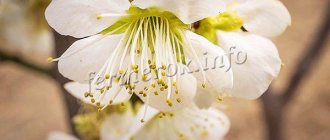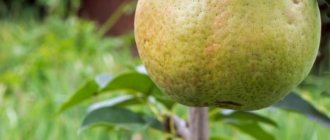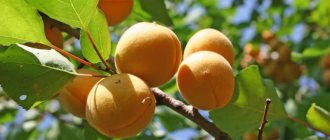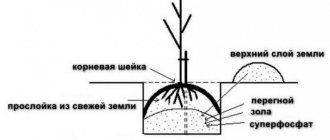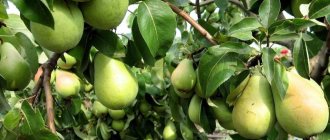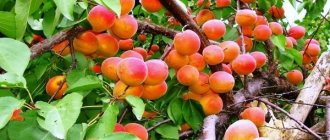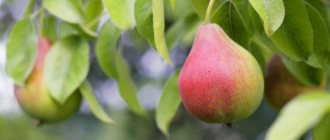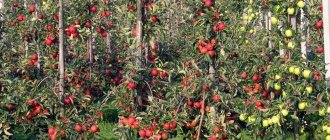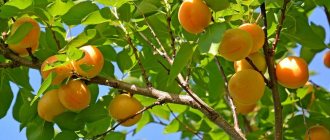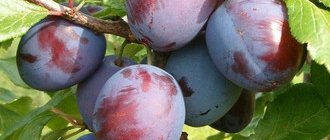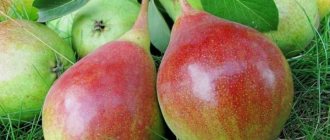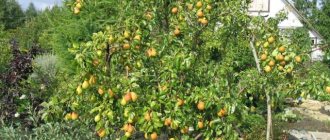The recently developed pear variety Simply Maria quickly spread in Russian gardens and farms. Its popularity was facilitated by the trees' tolerance to adverse factors and the excellent taste of the fruit. Like any other variety of fruit crop, Simply Maria has its own characteristics, which are useful for a gardener to know about.
- 2 Description and characteristics of the Just Maria pear
2.1 Video: review of the Just Maria pear tree with a harvest
- 4.1 Landing
History of selection
An autumn pear variety called Simply Maria was bred by crossing frost-resistant species resistant to many diseases with hybrids of the dessert group, characterized by an oily, rich taste. Among the parental hybrids: Bere sera, Late Belarusian, Dulya, Ro Maslyanaya. Work on crossing and selection began in the 90s by scientists from the Belarusian Research Institute of Fruit Growing under the guidance of a well-known practitioner, candidate of agricultural sciences Maria Myalik.
By 1996, several specimens were selected from among the seedlings, differing in taste, high immunity, and resistance to low temperatures. Using the forest pear rootstock, the seedlings were propagated in the breeding garden, where they underwent further research and observation. Thanks to their high performance, in 2003 the seedlings received elite status, and in 2006 the specimens were sent for state variety testing. In 2013, Simply Maria was included in the register and zoned in the Central region of Russia.
Breeding characteristics (according to state register data)
| Indicator name | Characteristic |
| Registered name | “Simply Maria” (Pyrus communis L.) |
| Originator | RNPD "Institute of Fruit Growing" |
| Year of registration | 2013 |
| Recommended growing region | seedlings have proven themselves well in the climatic conditions of the Central region (Moscow, Moscow, Ryazan, Belgorod, Voronezh, Kursk, Oryol, Smolensk, Tambov, Tula, Ivanovo, Bryansk, Vladimir, Kostroma regions) |
| Productivity | Fruiting occurs in the 5th year, young seedlings bear little fruit, from adult specimens they receive up to 72 centners per hectare |
| Description of trees | the seedling develops quickly, forming a spreading pyramidal crown of medium density |
| Description of fruit | The fruits are standard pear-shaped with a wide base, the color of the ripe fruit is green-yellow with a pink side, weight is 160-180 g |
| Taste qualities | The taste of the fruit was rated 4.8 points by professional tasters for sweetness, juiciness, delicate aroma and delicate, buttery pulp. |
| Ripening time | September October |
| Pollinators | Late varieties are suitable for cross-pollination, for example Duchess |
| Virus resistance | high |
| Preservation of fruits | in winter, about 90% of the total volume retains its presentation |
| Frost resistance | high, withstands down to -38 0C, when branches are frostbitten, the tree quickly restores its crown during the summer |
Caring for a pear Just Maria
To obtain a good and healthy harvest, the Simply Maria pear needs special care. The tree is not very demanding, it can cope with heat and frost, but the yield decreases.
Watering
The Simply Maria pear is drought-resistant, but this does not mean that you can’t water it. The tree is moisture-loving. Requires mandatory watering per season. One fruiting tree consumes 6–8 buckets of water. For young – 4 – 6 buckets of water at a time. The liquid is poured into the area around the tree trunk. Favorable periods for watering are:
- Before the juice begins to flow;
- During bud formation;
- During the flowering period;
- After the formation of ovaries begins;
- During fruiting;
- Winter watering.
Fertilizer
After planting, the tree is not fed for the first 3 years. The fertilizers placed in the planting hole will be enough to feed the seedling for a long time. From the fourth year, the pear is fed with organic and inorganic compounds. Suitable for pear:
- overripe manure;
- compost;
- wood ash;
- urea;
- copper sulfate;
- complex compositions for fruit trees;
- Bordeaux mixture;
- wood ash.
Each fertilizer is applied separately from each other. When choosing components, you need to pay attention to leaves and shoots. By their condition, you can determine the lack of an element.
It is important to carry out the procedure in different phases of the vegetative period:
- Before bud formation begins;
- During the flowering period;
- During the formation of ovaries;
- During the fruiting period;
- After the harvest.
Important! Excessive application of fertilizing leads to the death of the plant.
Mulching
The trunk circle of a garden tree is its heart. The pear receives nutrition and moisture through it. It is important to monitor it carefully. To do this, do the following:
- Loosen the soil 2 times a month to prevent the formation of an earthen crust;
- Remove root shoots;
- All weeds are pulled out;
- Mulch the area around the trunk.
Mulching helps retain moisture at the roots of the tree, prevents the proliferation of weeds, limits the penetration of infection through the root system, and makes tree care easier. Various materials are used for this:
- straw;
- sawdust;
- chopped grass;
- moss;
- pine needles;
- crushed stone
Important! If you use pine needles as mulch, the risk of mice breeding in it is reduced.
Crown formation rules
The goal of the most important agricultural technique is to maintain optimal crown size, density and fruitfulness. For the Simply Maria variety, it is desirable to form a cup-shaped crown, which is responsible for illumination of the internal volume, ventilation, ease of care and harvesting. Step-by-step instructions will help you carry out the operation correctly:
- With the arrival of spring, until sap flow begins, 1-2 years after planting the variety, 3-4 skeletal branches are selected, which are directed in different directions and placed on the trunk at 15–20 cm intervals. They need to be shortened by one third.
- The remaining pear shoots are cut into rings.
- Pruning of the central conductor of the variety is carried out above the base of the upper shoot.
- On the skeletal branches, after 1-2 years, 2 shoots of the second order are determined. They are located at the top of the skeletal branch. The distance between second-order processes is 0.5–0.6 m. They are shortened by 40%. Make sure that the shoots do not dominate and do not play the role of the main conductor. You will need to shorten the shoots and support them to the same length.
Pear pruning
An important stage in growing a pear is the formation of the crown:
- In the spring, before the sap begins to flow, carry out formative pruning. Leave several fruit shoots on one skeletal branch. Carry out the very first pruning immediately after planting the seedling.
- Shorten the central shoot by 15 cm, and trim all lateral branches to the growth point. Every year shorten the elongated crown to the tips of the uppermost tier of branches.
- Cut out all shoots growing inside the crown.
The pear tree does not branch much, so in the future carry out formative pruning as needed.
In the fall, sanitary pruning is required: cut out broken, diseased, dried and pest-damaged shoots. Carry out the procedure after harvesting and the leaves have fallen, when the plant is “sleeping”. After pruning, always treat the cuttings with garden varnish.
Rejuvenation
It’s just that Maria is too young a variety to confidently talk about the features of rejuvenation. The procedure is carried out based on the fact that its fruits are formed on ringlets and spears. In essence, rejuvenation comes down to thinning the crown and cutting out excess vertical shoots.
Pear trees often grow strong branches at an acute angle. It is better to cut such shoots into a ring. If the branch needs to be left, then a load is hung on it so that the branch takes on a horizontal position as it grows.
- A signal for rejuvenation is weak growth - less than 15–20 cm. First, thin out the crown, shortening the branches to 5–7-year-old wood.
- Renew rings. The lifespan of such an escape is 5–7 years. Accordingly, old rings should be cut into a ring. If the shoot has at least one healthy mature bud left, the branch is cut off above the bud. Next spring it will begin to grow rapidly.
- The pear tree does not have many overgrown branches, so their growth should be stimulated. To do this, in the spring they are shortened by ¼ or 1/5 of the length.
Description of fruits
Ripe fruits are medium in size, the maximum weight of some specimens reaches 220 g, the average - about 180 g. The pulp is characterized by a light yellow color, delicate consistency, and juiciness. The amount of sugar is average - about 8%, there is a slight sourness - up to 1%.
Ripe fruits have a harmonious taste, a not too strong aroma and an attractive appearance. The smooth, light skin with a noticeable dotted pattern is covered with a slight tan on fruits that ripen under the sun. The harvest is harvested in the fall and consumed when the fruits have settled. In a cool room, pears are stored until mid-winter.
Characteristics of wood
The Simply Maria tree can be described as follows:
- average height - up to 3 m;
- crown in the shape of a wide pyramid - up to 2.5 m in diameter;
- the branches at the ends are directed upward, and near the trunk they grow almost perpendicularly;
- density is average;
- loves the sun, but can tolerate shade.
Productivity
During the season you can get up to 15 tons of pear harvest from 1 hectare with an average level of 14.2 tons, and from 1 tree you can get up to 40 kg of fruit. The harvest ripens in October - November, the tree bears fruit regularly, the beginning is 3 years from planting, if an annual seedling is planted on a seed rootstock. The yield of marketable fruits is 90%.
Autumn ripening pears also include:
Advantages and disadvantages
Reviews from gardeners who have managed to purchase and plant a hybrid are quite good. Many unanimously name the following advantages:
- high resistance to scab and viral diseases;
- rapid development and onset of fruiting;
- partial self-fertility (according to the observations of farmers, a similar indicator is not indicated in the state register);
- high taste qualities;
- transportability, safety above average;
- endurance during winter frosts;
- regular harvest.
Disadvantages of the culture are associated with planting characteristics. If a tree is planted in the wrong place (soil, groundwater, lighting, drafts), it will develop and bear fruit poorly.
Reviews about the variety
You will find many positive reviews from gardeners online. Many of them consider this variety to be one of the best for its high yield and ease of care. One such review can be seen in the video below:
★★★★★
Inna, 34 years old, gardener. I just planted Maria 7 years ago.
I collected the first fruits already in the fourth year after planting. The pears are juicy, tasty, and smell nice. The tree bears fruit annually. I tried to propagate the variety by grafting. Of the seven cuttings, two took root on an apple tree and a wild pear tree. I like the variety because there is no need for regular care. ★★★★★
Roman, 25 years old, beginner gardener. It’s just that Maria has been growing on my plot for 8 years.
For the past 5 years I have been collecting ripe fruits, which I like for their sweetness and softness. The wife makes the jam, cooks compotes and juices. I noticed that if you regularly water and feed the plants, there are much more fruits on the tree than if you do not carry out any care procedures. ★★★★★
Egor, 47 years old, summer resident. I heard about the variety from a neighbor, bought and planted a young seedling at the dacha.
The yield is good, I collect about 50 kg of fruit from one plant. My family likes the fruits, but I’m so-so – I don’t really like sweet pears. The tree is tall, about three meters. In principle, there are no shortcomings, care is simple and does not require much time. ★★★★★
Eagle
Pear Just Maria, wonderful, sweet, juicy, large. For me, it began to bear fruit in the 3rd year. I wish there were more of them, such tasty varieties should be bred.
Hide
Add your review
Pear Simply Maria is an unpretentious plant, which is preferred by many gardeners who do not have much time to care for. If all agrotechnical measures are observed, the yield rate becomes many times higher, and a lot of fruit appears.
0
0
Copy link
Lighting requirements
To plant the Simply Maria pear, it is better to choose a well-lit southern or southwestern slope, protected on the northern or northeastern side by a fence, a natural barrier of other trees, or a house wall.
It is not recommended to plant trees on a site with the following characteristics:
- swampiness;
- high location of groundwater, proximity to a river, pond, rate;
- a ventilated place with strong gusty air currents;
- in the shade of neighboring large, spreading trees (you need space and plenty of sunlight).
On a note. On alkaline soils, the crop develops poorly, gets sick, and produces minimal yield. Before planting, it is advisable to check the acidity of the soil and neutralize the alkali.
Secrets of successful cultivation
Regardless of the region of cultivation, the basic activities for growing pears are standard. Compliance with some nuances in the process of caring for fruit trees allows you to get the best results and a high yield of quality fruits:
- Pear plants adapt relatively easily to acidic and slightly acidic soils, but they absolutely cannot tolerate an increased alkaline reaction, even at considerable depth.
- For soil with heavy loamy and light clayey mechanical composition, the critical level of groundwater is approximately one and a half meters.
- Rootstocks in the form of serviceberry and chokeberry are characterized by better winter hardiness than pear rootstocks, and the fruits ripen several days earlier than usual. However, such vaccinations are short-lived: their lifespan does not exceed seven years.
- A very good result is obtained by grafting pear fruit plants of different varieties, but of the same flowering and ripening period, which improves pollination and productivity.
- Completely unformed or improperly formed trees grow upward and have a narrow crown. It is recommended to pull strongly growing branches down to a horizontal position and secure them in this form for about a year.
The plant is moisture-loving and needs to be provided with abundant and fairly regular irrigation measures in the form of watering along the furrows. To get the highest quality fruits, fruit plantings should be provided with balanced nutrition at all stages of the growing season. It is also necessary to carry out timely pruning of fruit plants, which allows the crown of the pear tree to form correctly. Old plants need rejuvenating pruning. Any pruning must be accompanied by the treatment of wounds caused by the plant with garden pitch or other special compounds.
Soil requirements
For pears, neutral soil or very slightly acidic soil is suitable. It is advisable to prepare the planting hole in advance: if a seedling is purchased in the fall, the hole is prepared in the spring. The suitable diameter and depth of the hole is about 70 cm. Afterwards, the hole is filled according to the following scheme:
- drainage layer (required) – 5-10 cm;
- a mixture of peat, sand, humus, turf soil with the addition of a biostimulant is mixed in a bucket and poured in a layer of 20 cm;
- a peg is driven into the center of the hole;
- When planting, the root system is placed on prepared and fluffy soil, and covered with a mixture of turf soil and humus.
On a note. A young tree does not need fertilizer in the first 2 years, since unformed roots cannot absorb and distribute nutrients in high concentrations. As a result, they may get a chemical burn.
Features of reproduction
Maria simply reproduces in the following ways:
- By cuttings.
A branch with leaves is cut from an adult tree and placed in a container of water. After a few weeks, the cutting produces roots. For better root formation, place a Heteroauxin tablet in the water. Then the cuttings are planted in the ground and watered abundantly. It is advisable to carry out this procedure in the summer. The cuttings can first be planted in a greenhouse. For better rooting, the plant is watered up to 4-5 times a day.
- By layering.
A branch of an adult tree is bent down and covered with earth. The soil is well irrigated with water; the soil can be loosened first. The top of the branch with leaves remains above the ground. Roots form at the point where the shoot touches the soil. When the branch is well rooted, it is cut off from the parent tree. The time of the procedure is the season of intensive growth (from mid-spring to late summer). Branches for layering should be young and not yet lignified.
- By grafting.
A cutting with dormant buds is cut from the mother tree. A sharp cut is made at one end and a blunt cut at the other. A thin branch with two or three unopened buds in early spring, at the moment the sap begins to flow, is grafted under the bark of a tree, for example, a pear of a different variety. You can insert the cutting into a rootstock cut in half. The tree branches into which cuttings from another tree are inserted are cut down to stumps. Then Simply Maria is implanted into them. The junction is tightly wrapped with tape.
Drought resistance, winter hardiness
Young trees of the first and second years are hilled up for the winter, and the trunk is wrapped to prevent damage by rodents. Mature trees can withstand severe frosts. If the crown is frozen, the tree continues to bear fruit on new branches. In severe drought, the tree requires watering - about 30 liters per trunk circle once a week.
Simply Maria is a late dessert hybrid that blooms profusely and produces delicious fruits. Pears are used to make jams, baby purees, fruit compotes, and candied fruits. It’s just that Maria is a representative of an elite selection, recommended for home and farm cultivation.
Landing
For planting, choose a sunny location. Pear trees do not like strong winds, so they must be protected from them by buildings or behind-the-scenes plantings.
The soil must be fertile, free from perennial weeds, with a neutral reaction. The high level of groundwater will not allow you to create a fruit-bearing garden.
Important! To get rid of weeds, it is worth planting dahlia bushes at the future planting site, which are excellent at fighting perennial weeds. The planting site is dug in advance, late in the fall.
The settlement of the earth will not allow the root collar to be drawn into the ground, and the pear seedlings will be planted correctly.
The planting site is dug in advance, late in the fall. The settlement of the earth will not allow the root collar to be drawn into the ground, and the pear seedlings will be planted correctly.
Fertile soil does not need to be fertilized additionally; it will be enough to dig a hole the size of the roots of a young seedling. Poor soil must be additionally fertilized. The top layer of soil is mixed with 2 buckets of humus, 2 buckets of peat, 200 g of superphosphate and 400 g of potassium sulfate.
Important! Coarse sand must be added to clay soil; fine sand only compacts the soil structure.
Fertile soil is poured into a pre-prepared planting hole measuring 1.0 x 0.6 m, a garter stake is driven in and the seedling is planted. The roots should be carefully straightened, the soil should be compacted, and the seedling should be tied at the top and bottom with a figure eight. The peg will darken the young plant on the south side and will not allow the young roots to break off during strong winds.
After planting, 2-3 buckets of water are poured under the seedling, ensuring uniform soil settlement. The tree trunk circle is mulched with peat or sawdust.
Important! The best time is in April, before the buds swell, in the fall - after leaf fall, until mid-October.
If there is no room in the garden to plant a new tree, you can grow fruit-bearing branches from cuttings by grafting them into the crown of any autumn variety.
It’s just that Maria is zoned in the Central regions of the country, including the Moscow, Smolensk, Ryazan, and Kaluga regions. For growing in the Moscow region, it is best to choose self-rooted seedlings.
